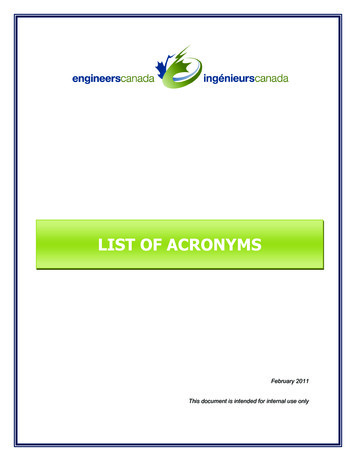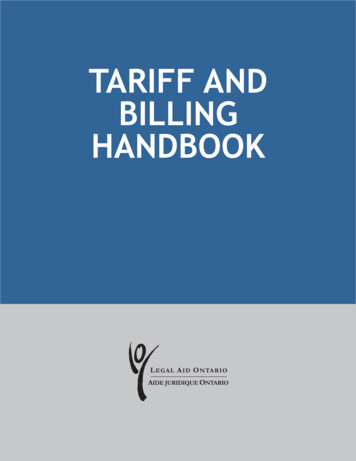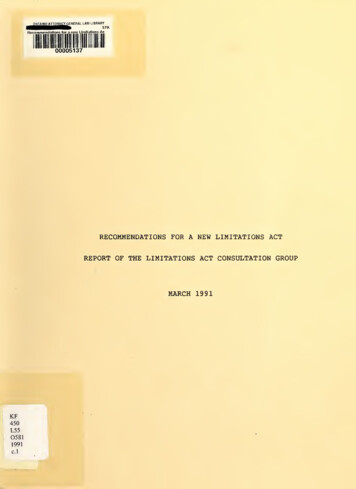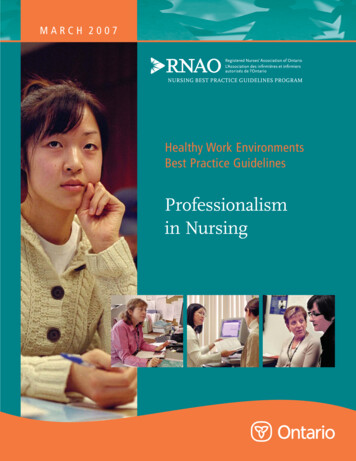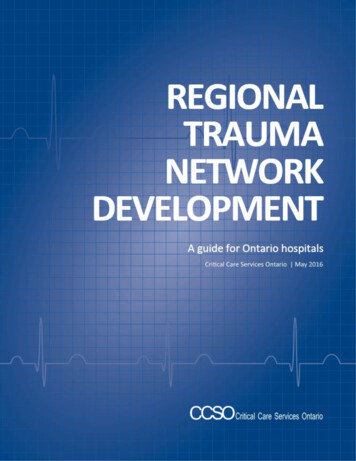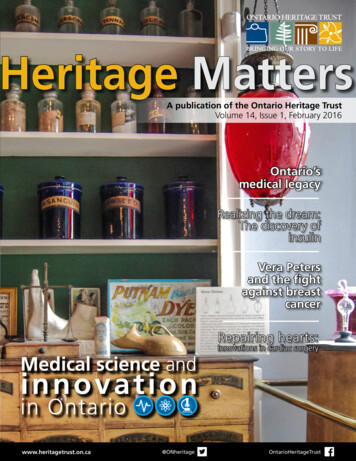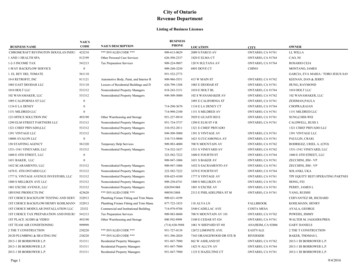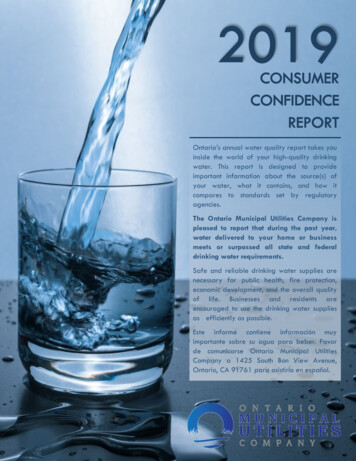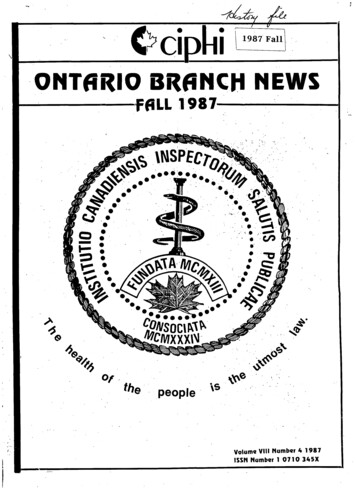
Transcription
ONTARIO BRANCHNEWS1-987Volume VIII Number 4 1987ISSN Number 1 0710 345X
: ,. You can relax,. when you use 'De Luxe'.watercare products from"Great Lakes Biochemical (Canada) Ltd.,WE'RE'THE EXPERTS'.'For Over thirty years; GrearLakes Biochemical(canada) Ltd. has earned the trust and respect ofCanadians as 'The Experts' in water care treatment,You'll find 'De Luxe' water care products being usedin.hospitals, burn care centres, rehabilitationprogrammes and therapeutic facilities all across.,isystem used so frequently today.THE 'DE LUXE'SEAL OF APPROVAL.yoU'll find 'De Luxe' registered water care productsavailable from over 9,000 professional dealers acrossCanada and the U.S.A. Just look for the 'De Luxe'seal of approval o n every product. It'sIn private pools, spas, hot tubs and therapeutic baths'De Luxe' products are the number one choice,product has been testedfor your healthand well-being and meets the highestof standards.our promise to you that each 'De Luxe'Canada, to control disease and ensure.public safety.WE'REHERETO HELP.our::professional staff include highly qualifiedmicrobiologists \,whose expertise is available free ofcharge to help with any water care problem youcould experience. And we know what we're doing,We invented and developed the two part bromideSO RELAX:Whenever you use 'De Luxe' water care productsfrom Great Lakes Biochemical (Canada) Ltd., youcad relax, knowing that you're getting the very bestprotection available.,-jGreatLakes(Biochemical)Canada Ltdi":::.:. .":: . ",Head office: 330 EsnaPark Drive,'Markham,Ontario L3R1H3Telephone (416)475-1372.Telex 06-986766.TOP/FAX 416-475-8546.:i .WORLD WIDE WATER TREATMENTSINCE 1956.]
'phi II 2ci0TARIOBRANCHNEWSEDITORSKlaus SeegerJohnOrrONTARIOVOLUME VHI NUMBER4, 1987BRANCH EXECUTIVEPresidentPeter MoccioPast PresidentJim rs1987-88Jeff ChretienCentralAreaPromoting Hygiene.Brant Health Unit Hosts Successful Tourney .HenryChongCentralArea JohnOrrWesternAreaEd hernAreaFOR P.H.I. FILEChemical Exposure from an Ice Tray Cabinet .Suspected Copper PoisoningTanning Salons Regulations Urged . : aCOMMITTEEPg. 99Pg. 100Pg. 95. Pg. 97Pg. 99.DEPARTMENTSCHAIRPERSONSRyersonAdvisoryJane UrquhartMOEAdvisoryEd RistanEducationIn.serviceHenryChongJeff ChretienEmployment OpportunityComing Events"".In The Courts -- A Costly Journey .i . .Payroll D eductionMembership Application .C.I.P.H.I. Membership Application Form. .Pg. 98Pg. 101Pg. 102Pg. 103Pg. 104Membership& Area MeetingJohnOrrPublicPolicy&InformationEd RistanConferenceLiaisonEd RistanProjectsBob FrattiniO.P.H.A.Unified VoicePeter MoccioSalarySurveyBob Frattiniways & MeansBob FrattiniBy-law - NominationJacques NadeauONTARIO BRANCH MEETINGSRyerson Area -- Convocation i987 .Pg. 94Deadline for Winter Issue is November 15, 1987Published Quarterly by the Canadian Institute of Public Health Inspectors (ONTARIO BRANCH) INC,Box 687, CLINTON, ONTARIO, N0M 1L0. Telephone 1-519-482-3416, EDITOR, KLAUS SEEGER. TheOpinions ofe,xpressedhereinare thoseof the authorsandarearereserved.not necessarilyof reproducedmembers ofwiththeInstitutethe C.I.P.H.I.ONTARIOBRANCH.Full rightsMaterial thosemay bepermission of the Editor and Author. S Jbscription is 4. per year.
page 94 Ontario Branch News Fall Volume 8 No. 4 1987This Issue:The annual Ontario Branch conference will be held in acouple of weeks from thiswriting. The venue is great and theagenda of speakers promises to be informative. During theconference the Annual business meeting will also be held. Aspart of the meetingthe votes Cast .for the Councillor positionswill be counted. So, it is very importaht that every member casttheir vote, either through the mail by ending it with a memberthat will be in attendance; .or by dropping it in the ballot boxwhile attending the conference.The conference also means that {he fall season is about tobegin. With such a gi-eat summer behind us' it isunderstandable th atvery, little in the Way of submissions haveRyerson Area "been received for this issue. However, we.have managed to puttogether sixteen pages of informative articles, some havebeen published previously. An example is 'Promoting Hygiene'Which is an article Pare Co0k submitted"fr()m an Irish dailynewspaper while on holiday. The concept presented may be.worthy of consideration in Ontario.'Gilles St. Pierre from North Bay submitted pictures-he tookat the annuaI.Slowpitch tourney held in-Brantford. Etobicokewon the championship, but no story or'summary has yet beenreceived from the good PeOPle ofBra'nt county.The Ryers0n Area held a meeting of sortsand Susan Huttonreported on the Ryerson convocation held at Massey Hall.Hope ,our summer wasn't too hectic and that the fallseason helps you catch up on all that was left behind.Convocation1 987.,.by SUSAN L. HUTTON,'B.A.A. 'Editor's Note: Following is a report on the third graduatingclass of the Bachelor,of.Applied Arts (Environmental Health).There were thirty grad uates. Most graduates have takenemployment in health agencies across Canada. Some willseek employment following Certification in SePtember.:The Ryerson. PolytechnicalInstituteSchoolofEnvironmental Health ,Convocation was held at Massey HallThursday,June 11,Convocationaddress thewasDegreegivenby Ms. Shirley;G.E. 1987.Carr. TheMr. JackPark presentedCandidates and ,Dr. Bdan Segal awarded the Degrees. TheDean's List was then read at the Convocation. The followingstudents graduated with the Bachelor of Applied Arts degreein Environrnental Health, as well as Continuing EducationCertificates-'.Nancy June Snider,,B.A.A., Public Administration certificate"Darwin Michael Trojan, B.A.A., Public AdministrationCertificateMary Ann Witruk, B.A.A." ,The graduates and their guests attended a receptionatRyerson following the Convocation Ceremony. Numerousawards were preser ted by Professor Timothy Sly, Chairman ofthe School of EnvironmentalHealth, to outstandingindividuals in the graduating classJanette Mclntosh was awarded in-recognition Of her specialservice to students and to Ryerson through her Course unionwork an d committees of academic council. Janette is currentlyemployed with the Ontario Ministry of Natural Resources.Kara Flannigan was .recognized for her service to fellowstudents while maintaining high academic standing. Kara hasRay Victori Alafato, B.A.A., Public Administration certificateserved as Student representative and Chairperson on theRyerson Council Area Seven of the Ontario Branch, CanadianVit0 Chiefari, B.A.A., Public Administration Certificate -Raymond M. Chong, B.A.A;, Occupational Health and Safety,Instit Jteof Public Health Inspe ct0rs.Kara is employed at theand Public Administration CertificatesA!goma Health Unit.Aniz Daya, B.A.A., Psychology of Human Relations and Public "Ray Alatalo was recognized for his service to fellowAdministration Certificatesstudents while maintaining high academic standing. Ray hasKara' Michele Flannigan, B,A.A., Public Administrationserved on the Environmental Health Course Union as theCertificate.Social Dii'ector, responsible for organizing student events. RayBartley Hinds Foster, B.A.A., Public Administration Certificateis currentlyemployedat the AlgomaHealthUnit.Mary Witrukwasawardedfor beingthe returningstudentTrevor Getty , B.A A.with the highest academic performance. Mary was alsoBrenda Kathryn Guarda, B.A.A., Public Administrationhonoreclby being placed on the Dean's List. Ms. Witruk.hasCertificate .' been publ!shed in the Environmental Health Review and isRogert Douglas Hall, B.A.A., Public Administration Certificateinte 'ested in pursuing graduate Studies sometime in theJudith Theresa Hope, B.A.A., Public Administration Certificatefuture,'.Daniel Gary Hunt B.A.A., Public Administration Certificate ". Andrew Kennedy received the Benton Award for 'high stSusan Lorraine Hutton, B.A.A., Economic Analysis and Publicoverall gradepoint average through four years of the program.Administration Certificates '"Andrew is a Bermudian citizen and.is currently cor pleting hisJenny Jung, B.A.A., -Psychology of Human Relations andfield training on a programat the City of Toronto Health Unit.Public Administi'ation CertificatesFollowing Certification With the .C.I,P.H.I., Andrew will beAndrew Ottis Kennedy; B.A.A., Public Administration'returning'to Bermuda tQtakeemployment,Certificate- ., Ms. Jane Urquhart was in attendance at the reception andKarl Thonas Kipr0ff, B.A.A., Public Administration Certificaterepresented the C.I.P.H.I. in the presentation of the InstituteVeronika Kozelj, B.A.A., Public Administration CertificateAward. Jane read a letter prepared by Mr. Peter M0ccio,Steven Robert Libera,'B.A.A., Public Administration CertificatePresident of the Ontario Branch, for the graduating Class ofLouisa Maalouf, B.A.A. pUblic Administration Certificate ., 87. This year's recipient of the C.I.P.H.I, Institute Award wasBernard Kirk Mayer, B.A.A., Contemporary Economic IssuesJoan Mays.Certificate.-Mr.Jack Park, past-Chairman.of the SchoolofJoan Frances Mays, B.A A.,Public Administration'CertificateEnvironmental Health was.present at the reception. Mr ParkHeather Mitchell, B.A.A,, Public Administration Certificatepreviewed the Alexander O'Hara Award and introduced Mrs.Kimberly Anne'MbDermott, B.A.A., Public Administration. Aiexander O'Hara to present the Award and plaque, Th eCertificate;- .,O'Hara Award is:given to the graduating Environmental HealthJanette Mclntosh, B.A.A 'Occupational Health and Safety and .studen{with the highest, grade pointaverage in professionalPublic Administration Certificates(EHE) Subjects.-The class of 1987 recipient was Joan Mays. "Laura Mary Missingham, B.A.A., Public AdministrationAlong with receiving the C.I.P.H.I. Award and O'Hara Award,CertificateJoan-Mays was honored by being placed on the Dean's List ofDavid Richard Pillar, B.A.A.-.Ryerson Polytechnicallnstitute. Also Joan managed part-timeDonna L! Quan, B.A.A., Public Administration Certificate .employment while maintaining her excellent academic- ,ndrea-SheilaRaiber, B.A.A., Public Administration Certificatestanding throughout the 4 year program. Joan Mays is on StaffMirjana Saveski, B.A.A., Psychology of Human Relations andat the Leeds, Grenville a'nd Lanark District Health Unit.Public AdministrationCertificatesContratulati0ns and Best'Wishes to the Graduates!o!
!'o-rPHI File, I:Ontario Branch News Fall Volume,.8 No. 4 1987 page 95{Editor's Note." Following is an article on "Suspected Copper Poisoning - British Columbia" from the O.D.S.R. Volume 8Number 16, August 7, 1987 and an article on the "ChemicalExposure From An Ice Tray Cabinet", British Columbia, fromthe O.D.S.R. Volume 8, Number11, May 29, 1987.Both articlesare u/ usual and illustrate that not all things that appear to befunctioning, always do. The ontario Disease SurveillanceReport (ODSR). is the weekly publication from the DiseaseControl and Epidemiology Service, Public Health Branch,Ministry of Health . " CHEMICAL EXPOSUREFROM AN ICE TRAY CABINET. .,- ,.*BRITISH COLUMBIACASE REPORT: "On Tuesday, October 14, 1986, Boundary Health Unitreceived a complaint that on the evening of October11,1986two or more persons had become ill shortly after consuming idrinks at a local bar lounge. (Unfortunately the complainantgave only minimal information on the.incident and was notavailab e for a rout ne Food Poisoning nvestigation nterview.)The complainant suggested that the drinks may have been!contaminated with a chemica s milar to Drano TM and noted!that all of the suspect drinks contained ice. INVESTIGATION:-The potential sources of 'the alleged contamination werelinitially thought to be either the beverage stock, the ice served,:or the glasses used for serving,The complainant's ment!on.of a chemical-like taste inthe;drinks suggested that there may have been high residues ofiodophorsanitizer left on the glasses from the lowtemperature glasswashing process used on the premises,Excessive sanitizer residues may have resulted from either 'rapid re-use of freshly sanitized glasses, or over-adjustment of the sanitizer feed system in the glasswasher. The latter wasthought possible as the glasswasher had a recent history oferratic functioning," The glass sanitizing agent was ruled out when it wasearned that the sanit zer purnp in the glasswasher had beenout of service for several days. 'During this period, glasses hadbeen sanitized manually after machine washing.It was noted that there was a' newly posted sign on theglasswasher instructing all staff to.handwash all dirty glasses,When interviewed, the operator explained that although themachine's wash-cycle was fully functional, the unit could notbe used because the large volume of water discharged per,,;wash-load was compounding a recent drain blockage problem.A large pool of water was found under the glasswasher. AmaintenanceWorker mentionedthat there had beenintermittent back-ups in the plumbing during the previousweek and that the water was spilled during a recent attempt tomechanically unplug the drains. He also added that repeated. uses of chemical drain cleaners on and since October 11, 1986had only gradually improved the situation.Detailed examination of the plumbing in the bar showedfixtures arranged as in Figure 1 below.The sewer connection to the ice tray (see Figure 2) wasfound to lack the air gap arrangement required by the B.C.Plumbing Code (Figure 3)."Removal of ice from the ice tray revealed the presence ofcongealed food grease within the tray itself and covering theheat exchanger manifold. Further dismantling of the cabinetby removal of the tray exposed a thick build-up of grease andtypica ! washing debris covering the entire surface of the lowercabinet.-,When questioned on the ice storage and use routinefollowed by the staff, the operator explained that the traywould normally be completely emptied of ice before it wouldbe refilled, and added that none of the bar staff had reportedany effluent in the ice cabinet during the recent drain backups.The premise was found to be in satisfactory conditionotherwise.A ;ater consultation with the Plumbing Inspector confirmed,that the operator of thebar had not received approval forinstallation of the fixture in question.The Plumbing Inspectoralso suggested that thegrease and food wastes found in the" cabinet had come from the grease trap common to the loungeand an adjacent restaurant.three Compartment ,.sink" ,ice trayIru. ,.discharge to sewerFigure 1continued on next page
page 96 Ontario Branch News Fail Volume 8 No. 4 1987ice tray;.iceheatexchangerc "gea'ed gre 'er" ,,I l"Ikcabinetlower.,,I[ -r"'to sewer.Figure 2discharge pipe.%.L J.-Dairgapf--2XDt"vessel/receiving1'Figure 3DISCUSSION:It appears from the evidence gathered that glass anddishwasher waste, possibly containing a chemical draincleaning compound, had backed-upinto the ice tray and thatsome of-the ice served to customers may have.been immersedinthis solution at some point in time. As the staff member hadmentioned that drain cleaner was used several times on theevening of October 11, without improving the drain blockage, itis possible that a significant sewer back-up occurred at thetime and that the drain cleaner concentrationin thebackflowing effluent was high; It is also likely that enough ofthe chemical contaminated the ice to produce ill effects in thepersons exposed to it.(Note: .As none of the suspect drinks were available foranalysis the presence of the presumed contaminant could notbe verified.)IMPLICATIONS:-This case demonstrates that:1. Bevei'age-ice storage trays must be protected by approvedair gaps, and where a heat exchanger ice tray is present in aFood Premises it'may Potentially.be used for the dispensing of beverage ice and should therefore also be provided Withan air gap.2. Public Health Inspectorsshould routinely check forappropriate backflow prevention devices on all food storageor holding equipment, etc., to which potable and/or nonpotable water plumbing is connected.3. Managers and maintenance personnel in Food Premisesmust be aware that all additions or alteratfons tO existingplumbing must be made in accordance, with the PlumbingCode.4. There is a need for educating persons who work in the FoodIndustry, regarding the potential hazards associated withthe use of cleaning chemicalsin food storage and serviceareas.ISOURCE"Article by A. Faremo. C.H.P.H.(C); reprinted in full from B.C.Disease Surveillance 1987: :68-72.COMMENT BY ODSR:This incident is a good example Of how a food poisoningoutbreak through bacterial or chemical contamination of afood occurred where the food handling'and operation of thepremises were considered to be acceptable.Unfortunately on the fixturessuch as those wHh an indirect
- ,waste requiring an air gap, the waste outlet is usually locatedin a hidden-away area under or behind the fixture. It is possiblethese fixtures were installed in the premises that wereoriginally used for other purposes, not requiring this type ofplumbing, or were placed after the original plumbing .wasinstalled and not inspected. It is also possible that plumbinginspection is not available to the area. Therefore, it issuggested that where these installations exist, or are newlyinstalled, the public health inspector check during his routineOntario Branch News Fall Volume 8 No. 4 1987 page 97mspections to see if the plumbing has been ,installedaccording to the Plumbing Code. .F xtures requiring an indirect discl arge arelistedin Ontario"' Regu/ation 736, Section 156, Plumbing Code.CONTACT:A. Chiasson, CPHI; Consultant, Public Health Inspection,Public Health Resource Service, Public Health Branch, OntarioMinistry of Health.' :.SUSPECTEDCOPPERPOSONING ' BRITISH COLUMBIAOn-February 12, 1987 at alsproximately 1:30 p.m., a call wasreceived from the proprietor of a local cafe that at least oneperson became ill (with nausea and vomiting) within a fewminutes after drinking a carbonated soft drink from the popmachine. At least two other people reported not feeling well,but left the premises immediately. The duration of thesymptomswas aboutThese premisesuse2a hours."post mix system" to dispense pop. Inthis type of system the water supply is pumped into a canistercontainingcarbondioxide(CO2)whichis under80 Ibs.pressure. Thecarbonatedwateris thensuppliedto individualsyrup flavours, and the mixing occurs at the valves. (Thisfroma"pre-mixsystem"in that thefinishedproductis' differssuppliedin tanks,the wateris suppliedto thedispensingunitas a coolant only, and there is no direct connection betweenthe water supply and the product).Upon inspection of the system, a malfunction of thebackflow prevention device, separating the carbonator and thepotablewatercarriedin g,to sellwasanysuspected,pop fromthe vending machine. Canned pop from the supplier wassubstituted.In order to determine the cause of a possible .crossconnection, the supplier completely disassembled thebackflow prevention device, and found no malfunction due tomaterial fatigue. It is suspected that the backflow preventorwas stuck slightly open due to some foreign material in thewater system, thereby creating a possible route for thecarbonated water to leach the copper from the copper pipe.A sample of beverage from the vending machine had beensaved as it was "bluish" in colour, as was the water from oneof the taps in the kitchen. The operator had noticed that thewater tap developed air surges when it was turned on, at thesame time as customers were complaining of symptoms. The"blue pop" was collected and shipped to the ProvincialLaboratory,to have it analyzed for copper content,The laboratory reported a copper concentration of 196 ppmand a lead concentration of 0.05 ppm. The acceptable limit ofcopper in drinking water is 1.0 ppm and the maximumpermissible limit for lead is 0.05 ppm. (In a previous occurrencein which the laboratory was involved in determining copperconcentrations, levels of 38 ppm and 30 ppm copper werefound.)The incident may have been prevented had there beenanother backflow prevention device on the water line. Thesafeguards installed, however, must be maintained and thesystems checked prior to daily use to determine whether anyCO2 may have made its way back into the water system. Theprocedure could be as simple as turning on water taps tocheck for any air surges in the water line. Had this been donehere, the problem may have become evident before theproduct was purchased and consumed.'.COMMENT BY B.C. DISEASE[SURVEILLANCE:"The check valve supplying water to the system was stuckopen by some foreign material which allowed the CO2 from thePost Mix System to enter the water supply and.leach copperfrom the copper piping.The type of dispensing equipment involved was equippedwith only one check valve, which is contrary to Section 14.02(b)of the Sanitation -and Operation of Food PremisesRegulations:"Every vending machine which incorporates in itsoperation the use of water for consumption by the publicshall be provided with two Check valves or an air gap orother device to prevent the entrance of carbon dioxide orcarbonated liquid into the water supply system."SOURCE:Reprinted in full from B.C. Disease Surveillance 1987; 8 (7):119-121.COMMENT BY ODSR:As noted in the above article, the maximum acceptableconcentration (MAC) of copper in Canadian drinking water is1.0 mg/L(l.0 ppm). The level found in the contaminated"bluepop" was nearly 200 times this J.evel.The blue colour was no:doubt caused by the Cupric(Cuz ) ion in solution.The MAC has been based on criteria of esthetics and taste.The taste threshold may be as low as 2.6-5.0 molL and stainingof laundry and plumbing fixtures may occur at levels as low asthe MAC of 1 ppm.Fatal poisoning has been reported upon ingestion of largequantities of copper sulfate (10 grams). Typical symptoms ofmild acute poisoning, as in this case, are vomiting, diarrhea,headache and cramps. In severe cases, mucosal damage;hepatic and renal damage; hypotension; sulfhemoglobinemia;and hemolytic anemia have been reported. However, the lowtaste threshold would probably limit exposure before a serioustoxic intake can occur.CONTACT:M.G. Harris, PhD., Disease Control and ElSidemiologyService,.Public Healt h Branch, Ontario Ministry of Health.ForPHIFileForPHIFile ForPHIFileForPHIFile ForPHIFile ForPHIFileForPHIFile ForPHIFileForPHIFileForPHIFile ForPHI FileForPHIFileHave you paid your dues?Why not try payroll deduction.-
\ iipage 98 Ontario Branch News Fall Volume 8 No. 4 1987EMPLOYMENT OPPORTUNITYLeeds, Grenville and LanarkDistrict Health UnitSudbury & District Health UnitWe have openings for 2 Staff Public HealthInspectors in our Smiths Falls office.Thesepositions are generalized, including both healthand land control work.Salary starts at 24,813. A car is provided forwork, with opportunity to sub-lease for personaluse. Our benefit package is excellent.Candidates must be certified Public HealthIrlspectors (C.P.H.I.C.) and possess a driver'slicence. Preference will be given to applicantswith a degree in Environmental Health.Please respond prior to September 25, 1987With both your resume and references to:Mr. D.W. Horsley, C.P.H.h(C)Director Public Health inspection services70 Charles StreetBrockville, OntarioK6V 1T3We have openings for staff Public HealthInspectors in our sub-offices. These positions aregeneralized, including both health and .landcontrol duties.Salary range from 26,137.06 to 31,643.64.Excellent benefit package.Applicants must be certified Public HealthInspectors C.P.H.I.(C) and possess a valid driver'slicense. Send resume and references to:Director of Administrative ServicesSudbury & District Health Unit1300 Paris CrescentSudbury, OntarioP3E 3A3LIGHTWEIGHTPOLYETHYLENESEPTICTANKIS EASYTOINSTALLA NewTypeof SepticTankis beingmanufactured,in CanadaBecausethe Wedcopolyethyleneseptic tank is.muchlighter thanconcretetanks,noheavyliftingequipment,is required,fordeliveryand installation."Approved by Canadian --StandardAssociation,-CAN3-B66-79and ioMinistryOfTheEnvironment.,.Ma.ufacturedbyWE;)( C)" !.oom,,,,,.1289 Newton,Boucherville',Oue.,canada J4B5H2 IN CONTAINERS"AVAILABLEAT DISTRIBUTORSIN MOSTAREASIN ONTARIO.
4.Ontario Branch News Fall Volume 8 No. 4 1987 page 99PROMOT!NGHYGI ENEby JOHN A. MURPHYEditor's Note." Following is a reprint of an article from the Irishdaily newspaper the "Sunday Independent". The article waspart of a feature section of the newspaper focusing on theIrish QualityControlAssociationNationalHygieneC rtificates and Awards.The story was published on June 14, 1987 and written by Mr.John A. Murphy, Chief Executive, Irish Quality ControlAssociation. The feature section was submitted to the OBN byPamela Cook following a vacation in Ireland this spring.In a new initiative to stimulate and encourage moreattention to hygiene, the Irish Quality Control Association lastyear introduced the Hygiene Approval Certificates for thosecompanies which attain a satisfactory level of hygiene,C.ompaniesassessed for the Association'sHygieneApproval Certificate are automatically considered for the IrishQuality Control Association National Hygiene Awards as arethose who already hold the IQCA Quality Mark. The HygieneApproval Certificate scheme, which is sponsored by theConnacht & Court Group, gives vital recognition to hygieneconscious firms within the Irish food and tourism industries,The Hygiene Certificates are much sought-after because ofthe prestige and the publicity that goes with them. Recipientscan also attract new customers, because of the independentsubstantiation of their hygiene standards.The Irish Quality Control Association has consistentlypromoted the need for Irish companies to take hygieneseriously. Hygiene .is not an expensive extra. It must be builtinto the production process and appreciated by all staf.f, .inorder to build a high. reputation for Irish firms and maintaintheir long-term viability,Companies entering the hygiene scheme are subject to athorough audit by the assessors. It covers the following'aspects in detail:--Structural Layout--Food Storage and Protection"Cleaning Facilities--Insect and Pest Control--Staff Facilities--Staff Dressefficiency by up to 80 per cent. This indicates that time andmoney spent on training arid education can reap highdividends in the long run. Every food company, hotel,restaurant or retailer intent on improving their knowlege ofhygiene should purchase a copy of "Hygiene in Practice",publishedby Gill and Macmillan.This is the firstcomprehensive guide to hygiene published in Ireland and iswritten in a simplistic style.The commitment and initiative for training must come frommanagement. They should themselves be aware of theimportance of hygiene and the need to establish a hygieneprogramme which can be undertaken by trained operatorsunder professiona supervision.The Irish Quality Control Association Hygiene ApprovalCertificateand the NationalHygiene Awardsgivemanagement a goal to work towards, as well as giving staff anincentive to adopt hygienic practices.Every firm is avowedly aiming for excellence, but there canbe no degree of excellence in the food industry unless there isa serious commitment to hygiene. Without it you may find allthe hallmarks of a slip-shod company: food poisoning, foodspoilage, loss of productivity, prosecutions and even closure.Supreme Award, a balancing system is worked out. Forexample, to overcome difficuties associated with compar n ameat processor toa hotelier, certain aspects of hygiene aregiven weightings. When two companies are found to have thesame highest mark, the deciding factor is the commitment tohygiene shown by the management.Failure to attain high standards of hygiene is most oftenattributed to lack of hygiene education. Basic personal andIn each of the categories 8.9 per cent of the marks arerequired to receive a Hygiene Certificate whilst an award is--Generalgiven to theGroundsfirm which achieves the highest marks, providedthat they are over 85 .per cent. To choose the winner of the'-Experienceshows that proper training- can increaseon. completion of secondary education. Afterwards, thisshould be complemented and reinforced by training infoodhygieneshouldbe understoodby allthatchildrenindustry.Hereprinciplesit is up tomanagementto ensurestaffreceive adequate education relating to hygiene.TANNING SALON REGULATIONS URGEDEditor's Note: Following is an article submitted by PamelaCook, which refers to the need for more control of tanningsalons through regulations. It was first lSublished on June 26,1987 in the Toronto Star./OTTAWA (CP)-- People may be getting burned more than theyrealize by tanning salons, says the Consumers' Association ofCanada.It says clients risk eye damage and bad burns if a tanningsalon uses the wrong type of bulb or does not ask if they havetaken drugs or used cosmetics that could increase sensitivityto ultraviolet rays.At the association'srecent annual meeting, membersendorsed a motion urging the Health Protection Branch ofHealth and Welfare Canada to regulate commercial tanningfacilities,The association says tanning operations have to meetsanitation regulations to stay open, but health inspectorshaveno power to force owners to use correct bulbs, make clientswear protective eye goggles, limit exposure times or screenclients for theuse of drugs, chemicals and cosmetics, Whichthe association says are essential for safe operations.The federal Radiation Emitting Devices Act should beamended to include commercial tanning operations, theassociation says.
Ed Ristan Projects Bob Frattini Ryerson Area --Convocation i987 . Pg. 94 O.P.H.A.UnifiedVoice PeterMoccio SalarySurvey Deadline for Winter Issue is November 15, 1987 Bob Frattini ways &Means Published Quarterly by the Canadian Institute of Public Health Inspectors (ONTARIO BRANCH) INC, Bob Frattini Box 687, CLINTON, ONTARIO, N0M 1L0 .
